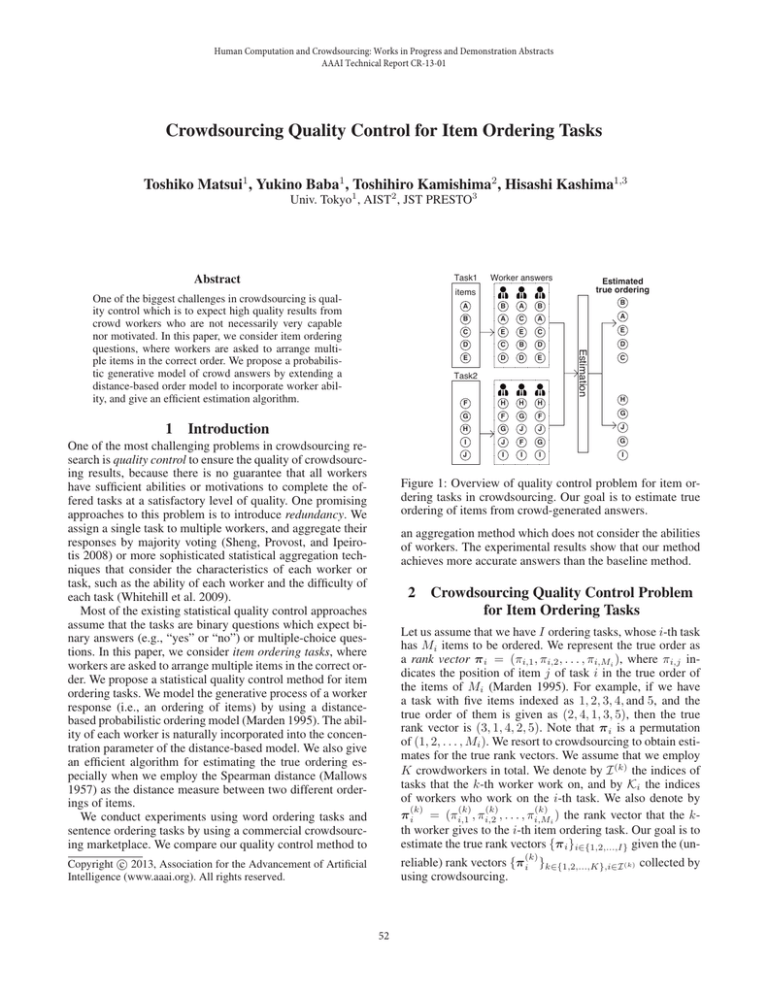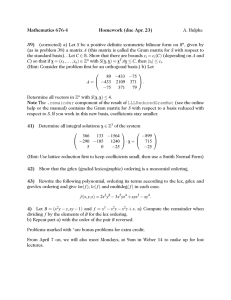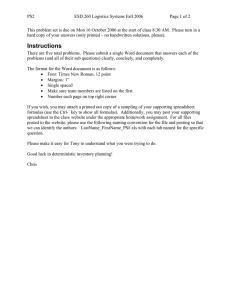Crowdsourcing Quality Control for Item Ordering Tasks Toshiko Matsui , Yukino Baba
advertisement

Human Computation and Crowdsourcing: Works in Progress and Demonstration Abstracts
AAAI Technical Report CR-13-01
Crowdsourcing Quality Control for Item Ordering Tasks
Toshiko Matsui1 , Yukino Baba1 , Toshihiro Kamishima2 , Hisashi Kashima1,3
Univ. Tokyo1 , AIST2 , JST PRESTO3
Task1
Abstract
Estimated
true ordering
A
B
A
B
B
A
C
A
C
E
E
C
D
C
B
D
E
D
D
E
Task2
Introduction
One of the most challenging problems in crowdsourcing research is quality control to ensure the quality of crowdsourcing results, because there is no guarantee that all workers
have sufficient abilities or motivations to complete the offered tasks at a satisfactory level of quality. One promising
approaches to this problem is to introduce redundancy. We
assign a single task to multiple workers, and aggregate their
responses by majority voting (Sheng, Provost, and Ipeirotis 2008) or more sophisticated statistical aggregation techniques that consider the characteristics of each worker or
task, such as the ability of each worker and the difficulty of
each task (Whitehill et al. 2009).
Most of the existing statistical quality control approaches
assume that the tasks are binary questions which expect binary answers (e.g., “yes” or “no”) or multiple-choice questions. In this paper, we consider item ordering tasks, where
workers are asked to arrange multiple items in the correct order. We propose a statistical quality control method for item
ordering tasks. We model the generative process of a worker
response (i.e., an ordering of items) by using a distancebased probabilistic ordering model (Marden 1995). The ability of each worker is naturally incorporated into the concentration parameter of the distance-based model. We also give
an efficient algorithm for estimating the true ordering especially when we employ the Spearman distance (Mallows
1957) as the distance measure between two different orderings of items.
We conduct experiments using word ordering tasks and
sentence ordering tasks by using a commercial crowdsourcing marketplace. We compare our quality control method to
B
A
E
Estimation
One of the biggest challenges in crowdsourcing is quality control which is to expect high quality results from
crowd workers who are not necessarily very capable
nor motivated. In this paper, we consider item ordering
questions, where workers are asked to arrange multiple items in the correct order. We propose a probabilistic generative model of crowd answers by extending a
distance-based order model to incorporate worker ability, and give an efficient estimation algorithm.
1
Worker answers
items
D
C
H
F
H
H
H
G
F
G
F
H
G
J
J
J
I
J
F
G
G
J
I
I
I
I
G
Figure 1: Overview of quality control problem for item ordering tasks in crowdsourcing. Our goal is to estimate true
ordering of items from crowd-generated answers.
an aggregation method which does not consider the abilities
of workers. The experimental results show that our method
achieves more accurate answers than the baseline method.
2
Crowdsourcing Quality Control Problem
for Item Ordering Tasks
Let us assume that we have I ordering tasks, whose i-th task
has Mi items to be ordered. We represent the true order as
a rank vector π i = (πi,1 , πi,2 , . . . , πi,Mi ), where πi,j indicates the position of item j of task i in the true order of
the items of Mi (Marden 1995). For example, if we have
a task with five items indexed as 1, 2, 3, 4, and 5, and the
true order of them is given as (2, 4, 1, 3, 5), then the true
rank vector is (3, 1, 4, 2, 5). Note that π i is a permutation
of (1, 2, . . . , Mi ). We resort to crowdsourcing to obtain estimates for the true rank vectors. We assume that we employ
K crowdworkers in total. We denote by I (k) the indices of
tasks that the k-th worker work on, and by Ki the indices
of workers who work on the i-th task. We also denote by
(k)
(k)
(k)
(k)
π i = (πi,1 , πi,2 , . . . , πi,Mi ) the rank vector that the kth worker gives to the i-th item ordering task. Our goal is to
estimate the true rank vectors {π i }i∈{1,2,...,I} given the (un(k)
reliable) rank vectors {π i }k∈{1,2,...,K},i∈I (k) collected by
using crowdsourcing.
c 2013, Association for the Advancement of Artificial
Copyright Intelligence (www.aaai.org). All rights reserved.
52
Proposed Method
8
6
8
10
12
14
8
6
4
π̃
Baseline
Ours
2
exp −λ(k) d(π̃, π i ) . (1)
Our strategy to optimize the objective function (1) w.r.t.
{λ(k) }k and {π i }i is to repeat the two optimization steps:
the one w.r.t. {λ(k) }k and the one w.r.t. {π i }i . Given all
the worker ability parameters {λ(k) }k fixed, the optimal true
rank vector π i for task i is given as follows. First, for each
item m(= 1, . . . , Mi ), we calculate a weighted rank wi,m
which is a weighted mean of the ranks given by workers
weighted by the worker abilities, that is,
1 X (k) (k)
wi,m =
λ πi,m .
|Ki |
4
6
8
10
12
14
Number of workers per task
(b) Sentence ordering
Figure 2: Experimental results.
k∈Ki
squared error) between each estimated rank vector and the
ground truth rank vector. We also tested a baseline method
which does not consider worker ability. In order to investigate the impact on the estimation accuracy by the number of workers assigned to each task, we randomly selected
n (ranging from 3 to 15) workers from the all workers for
each task, and only used the selected responses for estimation. We examined the averaged estimation errors of 50 trials. Figure 2 shows that the proposed method outperformed
the baseline method for more than five or six workers.
The true item ordering is given by sorting the items by
wi,1 , wi,2 , . . . , wi,Mi in ascending order.
Optimization with respect to the worker ability parameters λ(k) with true rank vectors {π i }i fixed is easily performed by numerical optimization, since the objective function (1) is represented as the sum of K independent optimization problem with only one variable.
4
6
(a) Word ordering
Averaged squared error
X
4
4
Number of workers per task
k i∈I (k)
+ log
2
Averaged squared error
where d(·, ·) denotes the Euclidean distance (also known as
the Spearman distance in the ranking model literature), and
Z(λ(k) ) is a normalizing constant.
We apply maximum likelihood estimation to obtain estimates for the true rank vectors as well as the worker ability
parameters. The log-likelihood function L is given as
X X
(k)
(k)
L({λ }k , {π i }i ) = −
λ(k) d(π i , π i )
Baseline
Ours
0
To solve the problem of aggregating the crowd-generated answers for item ordering tasks, we first give a statistical model
of the generative process of worker responses. Our model is
based on a distance-based ordering model (Marden 1995).
The probability of a rank vector π̃ given a true order π and
the k-th worker’s ability parameter λ(k) > 0 is defined as
1
(k)
Pr[π̃ | π, λ(k) ] =
exp
−λ
d(
π̃,
π)
,
Z(λ(k) )
0
3
Experiments
We used a crowd sourcing marketplace Lancers (http://
lancers.jp) to collect two crowdsourced datasets; one is for
word ordering tasks, and the other is for sentence ordering
tasks. Word ordering is a task aiming to order given English
words into a grammatically correct sentence. Workers are
shown an English sentence with five or six randomly shuffled words, and they are asked to correct the order of the
words. Sentence ordering is a task to order given sentences
so that the aligned texts logically make sense. Workers are
presented a paragraph consisting of five or six sentences
whose order is permuted, and they are requested to rearrange
them correctly.
We applied our method to the two crowd-generated
datasets, and calculated the Spearman distance (i.e., the
References
Mallows, C. L. 1957. Non-null ranking models. I.
Biometrika 44:114–130.
Marden, J. I. 1995. Analyzing and Modeling Rank Data,
volume 64. CRC Press.
Sheng, V. S.; Provost, F.; and Ipeirotis, P. G. 2008. Get
another label? improving data quality and data mining using
multiple, noisy labelers. In ACM SIGKDD.
Whitehill, J.; Ruvolo, P.; Wu, T.; Bergsma, J.; and Movellan,
J. 2009. Whose vote should count more: Optimal integration
of labels from labelers of unknown expertise. In Advances
in Neural Information Processing Systems 22.
53








